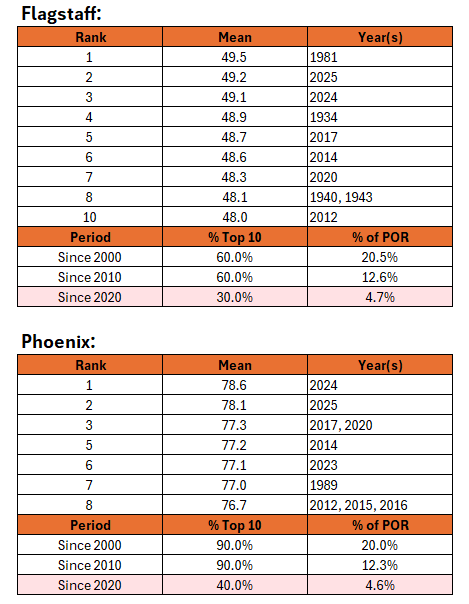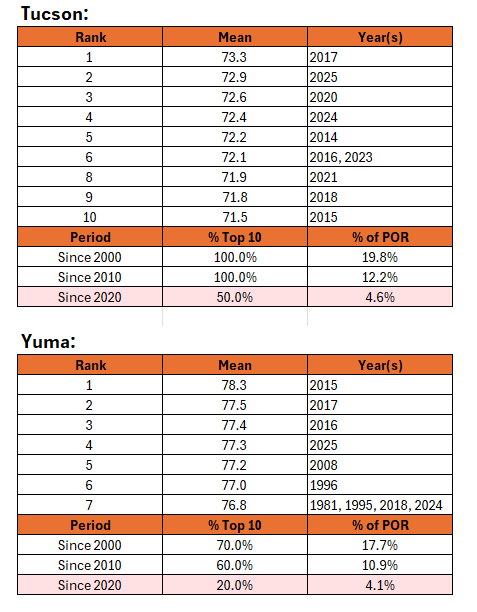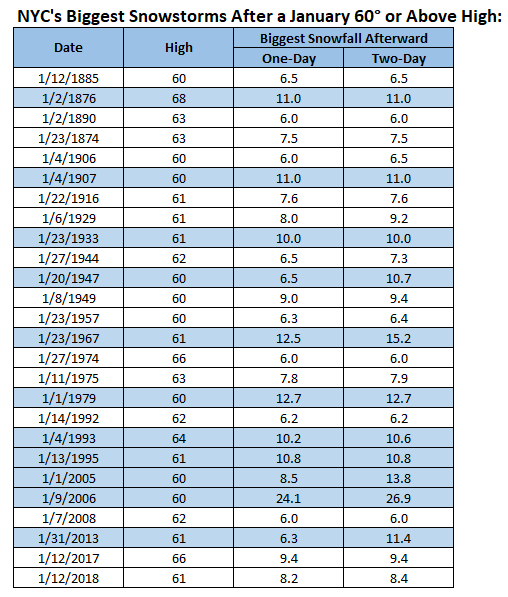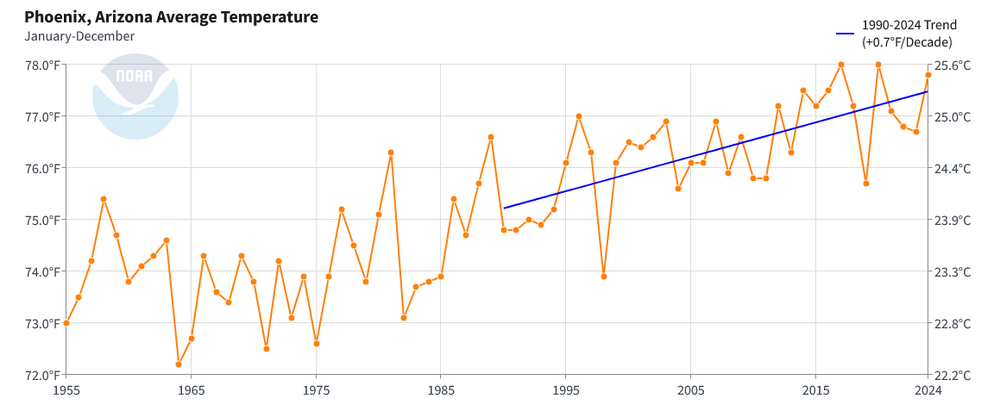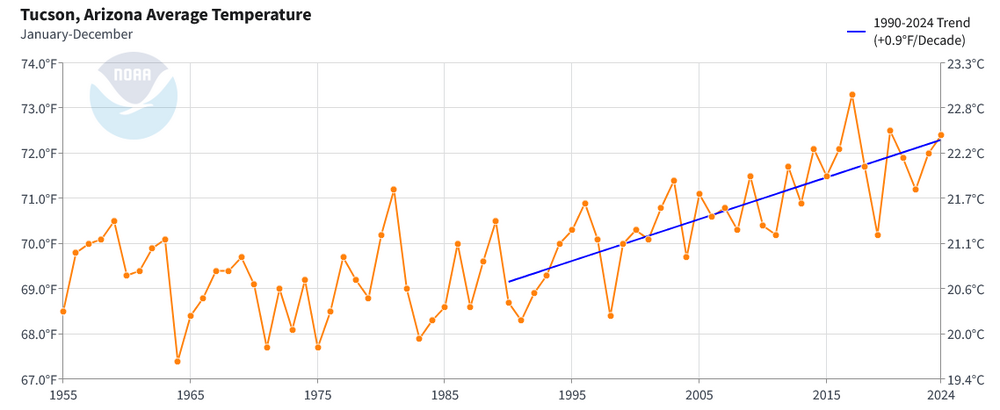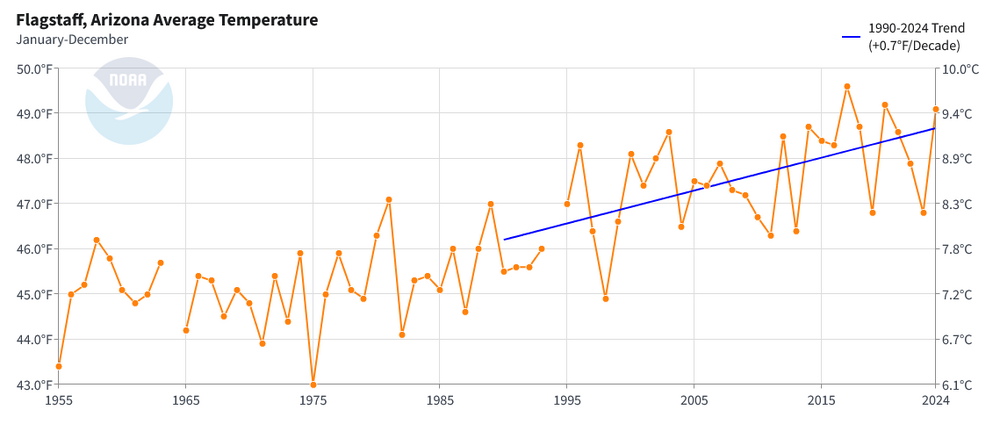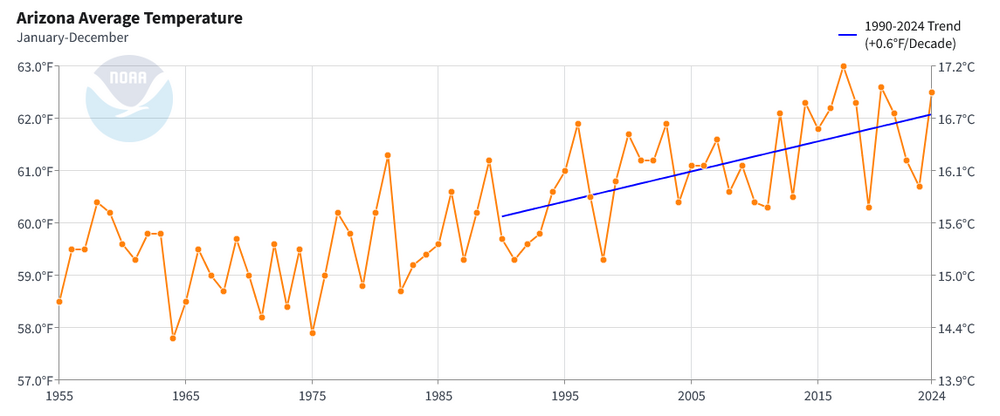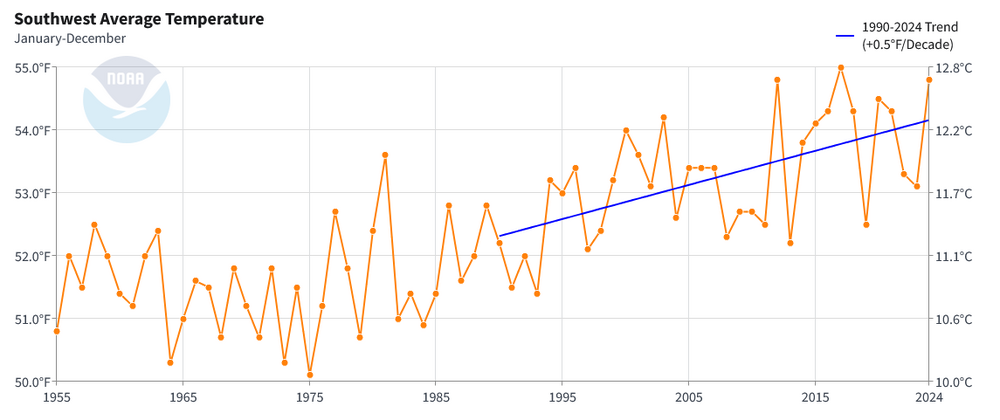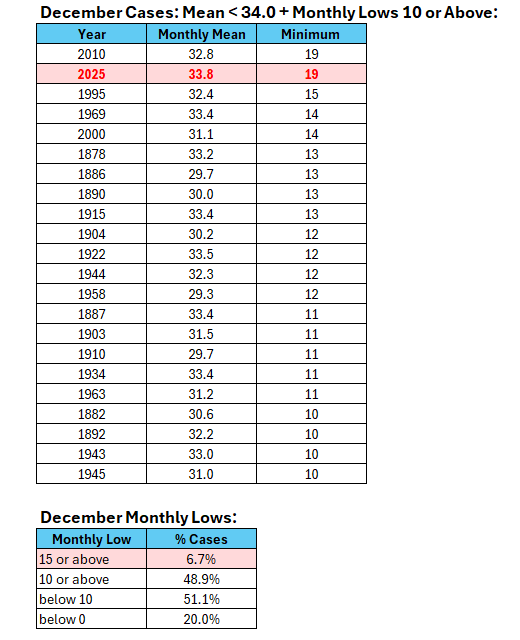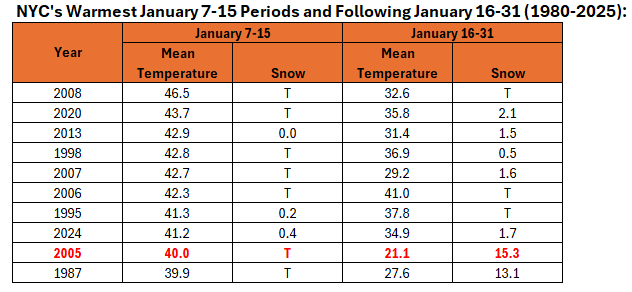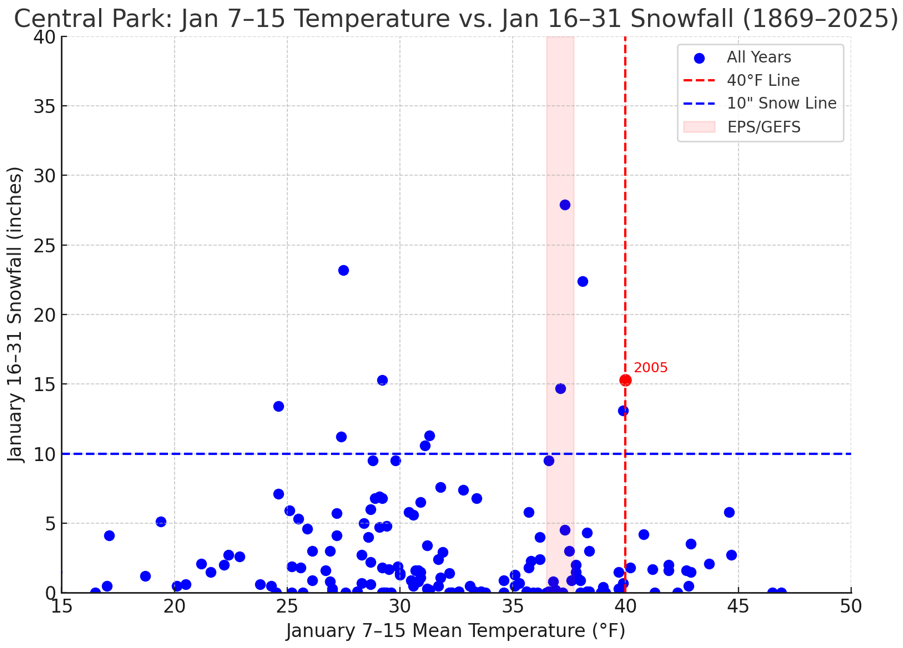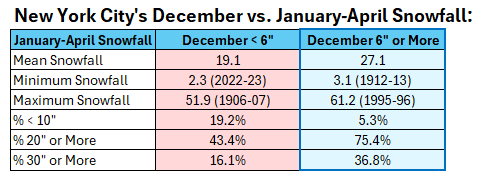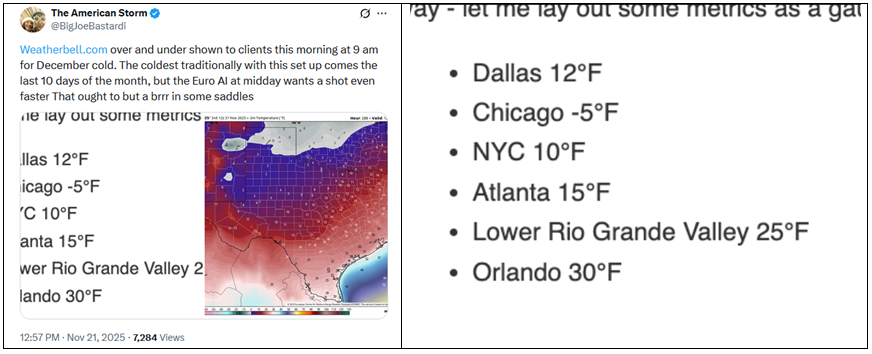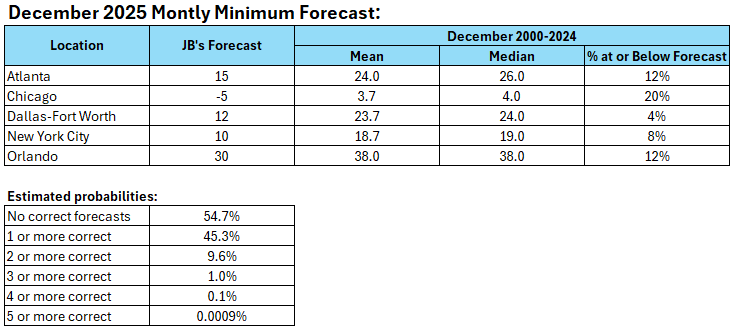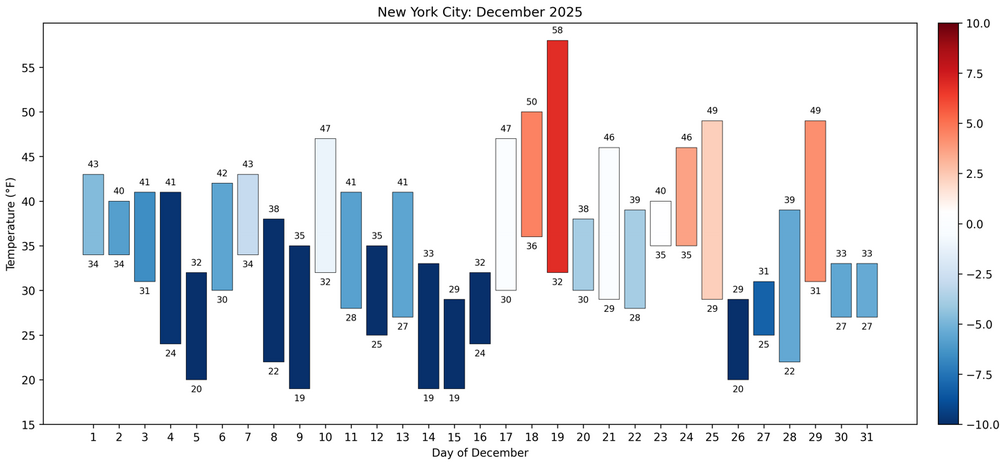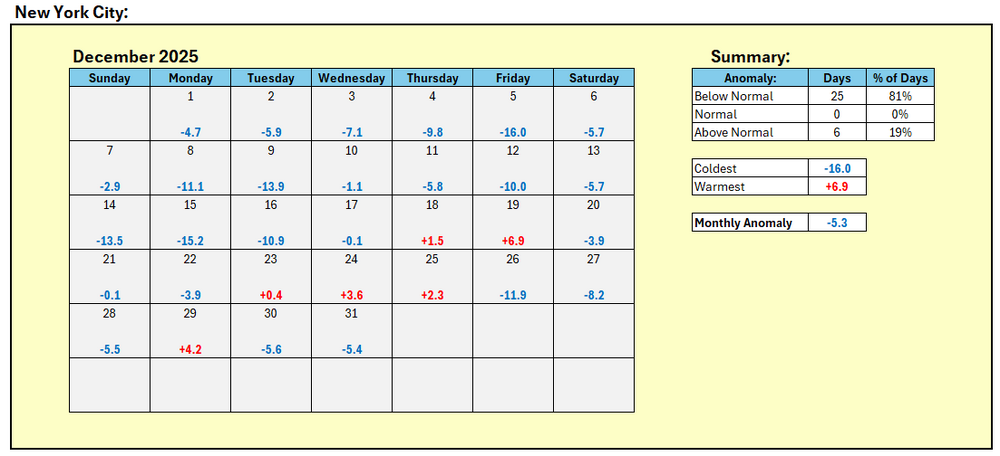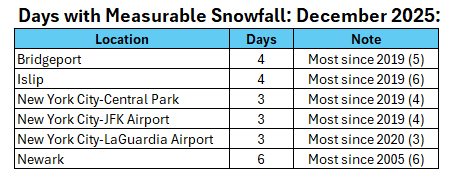-
Posts
23,073 -
Joined
Content Type
Profiles
Blogs
Forums
American Weather
Media Demo
Store
Gallery
Everything posted by donsutherland1
-
A few snow showers are possible in parts of the region late tonight and early tomorrow. Some areas could receive a dusting of snow. Tomorrow will see highs finish near or just above freezing in New York City. Milder weather will likely begin to overspread the region on Tuesday. The milder period appears likely to last for about a week, but there is some uncertainty about its duration. Afterward, conditions could become more favorable for both cold and snowfall, especially if the PNA goes positive. Rain is possible on Friday into Saturday. The ENSO Region 1+2 anomaly was -0.3°C and the Region 3.4 anomaly was -0.7°C for the week centered around December 24. For the past six weeks, the ENSO Region 1+2 anomaly has averaged -0.33°C and the ENSO Region 3.4 anomaly has averaged -0.68°C. La Niña conditions will likely continue into at least late winter. The SOI was +11.55 today. The preliminary Arctic Oscillation (AO) was -2.939 today.
-
A few flurries are possible in parts of the region late tonight and early tomorrow. Some areas could receive a dusting of snow. Tomorrow and Monday will be mainly dry and unseasonably cool days with highs finishing near freezing in New York City. Milder weather will likely begin to overspread the region on Tuesday. The milder period appears likely to last for about a week, but there is some uncertainty about its duration. Afterward, conditions could become more favorable for both cold and snowfall, especially if the PNA goes positive. The ENSO Region 1+2 anomaly was -0.3°C and the Region 3.4 anomaly was -0.7°C for the week centered around December 24. For the past six weeks, the ENSO Region 1+2 anomaly has averaged -0.33°C and the ENSO Region 3.4 anomaly has averaged -0.68°C. La Niña conditions will likely continue into at least late winter. The SOI was +9.62 today. The preliminary Arctic Oscillation (AO) was -2.782 today.
-
-

Texas 2026 Discussion/Observations
donsutherland1 replied to Stx_Thunder's topic in Central/Western States
The temperature soared to 89F (31.7C) in San Antonio. That tied the all-time January record that was set on January 30, 1971. -
Monthly outcomes are the result of climate change, synoptic patterns and, in the major cities, urban heat island effect. Monthly outcomes are useful for illustrating how synoptic patterns translate in a warming climate. Flagstaff, Phoenix, Tucson, and Yuma have all seen a disproportionate share of their top 10 warmest years since 2000, 2010, and 2020. This skewing of results speaks strongly, but not entirely, of how the region's climate has changed. Similar skewing can be seen in the Arizona statewide data for warmest years and the Southwest regional data for the warmest years.
-
The weekend looks to be mainly dry with colder than normal temperatures. A few flurries are possible in parts of the region early Sunday. The first week of January could have a mean temperature below 30° in New York City. If that happends, it would be the coldest opening week of January since 2018. The only years since 2000 with a sub-30° mean temperature for the opening week of January were 2001, 2010, 2014 and 2018. Milder weather will likely develop on or around January 7th. The milder period appears likely to last for about a week, but there is some uncertainty about its duration. Afterward, conditions could become more favorable for both cold and snowfall, especially if the PNA goes positive. The ENSO Region 1+2 anomaly was -0.3°C and the Region 3.4 anomaly was -0.7°C for the week centered around December 24. For the past six weeks, the ENSO Region 1+2 anomaly has averaged -0.33°C and the ENSO Region 3.4 anomaly has averaged -0.68°C. La Niña conditions will likely continue into at least late winter. The SOI was +9.29 today. The preliminary Arctic Oscillation (AO) was -1.828 today.
-
We won't know until the data is posted this evening. There were no local storm reports.
-

2025-2026 ENSO
donsutherland1 replied to 40/70 Benchmark's topic in Weather Forecasting and Discussion
Today is the 32nd consecutive day on which the PNA is < 0. Despite the EPS and GEFS currently showing only a brief turn to positive, the historic evidence since 1980 suggests that a regime change to an extended period of a predominantly positive PNA is likely once the current stretch of PNA- concludes. Until one is in the short-range of the teleconnection forecasts, the base case remains a regime shift in the PNA, not a temporary fluctuation to positive values. All 10 prior streaks of 30 or more consecutive days since 1980 ended with a regime change in the PNA. -
-
Phoenix is a high profile city in a rapidly warming region. A focus on Phoenix with respect to the region's changing climate makes good sense. A warming climate leads to an increased frequency of warm temperature records, all other variables notwithstanding. Additional variables include synoptic patterns and the urban heat island effect. Overall, the climatic warming is not unique to Phoenix. Moreover, despite misinformed social media efforts following Phoenix's August-record 118° temperature, the siting of the thermometer is irrelevant. The site has been certified and it is one of only a handful with a backup sensor to assist with validation. It also has an outstanding NWS office that is exceptionally responsive to possible issues when they occasionally arise. Some temperature trends in Phoenix, Tucson, Flagstaff, Arizona, and the Southwest are below. Phoenix is in line with Arizona's major cities and not out-of-line with either the entire state of Arizona or the Southwest, which include many rural areas. The modest differences suggest that most of the recent long-term warming is now being driven by the region's changing climate, not factors specific to Phoenix.
-
December 2025 tied Central Park's record for the highest monthly minimum temperature for any December with a monthly mean temperature below 34.0°. Fun fact: 15/21 (71%) of those cases prior to 2025 had seasonal snowfall of 30" or more, including 9/21 (43%) with 40" or more. Just 1/21 (5%) had less than 20" seasonal snowfall (1958-59 with 13.0").
-
I hope you feel better.
-
For reference, here's how New York City fared in terms of mean temperatures following the warmest January 7-15 periods (1980-2025): Both the 1/1/2026 12z EPS and GEFS are quite a bit cooler than the lowest value on the above table. Below is a scatter diagram showing all cases, including the shaded region for the current EPS and GEFS forecasts. In short, even if the January 7-15 period winds up warmer than normal, as is now the consensus on the guidance, its warmth does not provide basis to write off all of January, even as a colder January 7-15 period has typically preceded snowier than normal second halves of January. Now, if the warmth reaches a magnitude much higher than the present guidance e.g., above 40.0°, then snowfall prospects for the second half of January would become markedly lower.
-
I was surprised, too. We’ll see whether anything measurable is added in the climate entry.
-
Final Snowfall Totals from the Snow Squall: Bridgeport: Trace Islip: 0.4" New York City-Central Park: 0.5" New York City-JFK Airport: 0.4" New York City-LaGuardia Airport: Trace Newark: 0.7"
-
A snow squall associated with an Arctic cold front brought Central Park its first measurable New Year's Day snowfall since 1987. In the wake of the frontal passage, a series of cold days lies ahead. The first week of January could have a mean temperature below 30° in New York City. If that happends, it would be the coldest opening week of January since 2018. The only years since 2000 with a sub-30° mean temperature for the opening week of January were 2001, 2010, 2014 and 2018. Milder weather could develop on or around January 7th. The milder period appears likely to last for about a week, but there is some uncertainty about its duration. Afterward, conditions could become more favorable for both cold and snowfall, especially if the PNA goes positive. The ENSO Region 1+2 anomaly was -0.3°C and the Region 3.4 anomaly was -0.7°C for the week centered around December 24. For the past six weeks, the ENSO Region 1+2 anomaly has averaged -0.33°C and the ENSO Region 3.4 anomaly has averaged -0.68°C. La Niña conditions will likely continue into at least late winter. The SOI was +2.39 today. The preliminary Arctic Oscillation (AO) was -0.973 today.
-
That's only through 7 am. I suspect that the final number will show measurable snowfall at LaGuardia.
-
Just midnight through 7 am. As noted some locations were still receiving snowfall. A subsequent update should cover the final amounts. Moreover, since I was showing only snowfall from the squall, that omitted the 0.1" that fell at Newark yesterday.
-
While some might be tempted to cancel winter with the 12z guidance having few, if any, snow threats beyond mid-January, a snowy December typically favors more snow during January-April than when December is not snowy. I'd take my chances given where things stand.
-

2025-2026 ENSO
donsutherland1 replied to 40/70 Benchmark's topic in Weather Forecasting and Discussion
I agree regarding the TNH+ and NAO. However, at least as far as January is concerned (1980-2025), the NAO was < 0 on 63% of days when the EPO was < 0. Since 2015, that figure was 72%. A larger period beyond January 1-31 is likely involved in the linkage between EPO- and NAO+. -

2025-2026 ENSO
donsutherland1 replied to 40/70 Benchmark's topic in Weather Forecasting and Discussion
-
This morning's snow squall brought Central Park its first measurable snowfall on New Year's Day since 1987. All amounts are preliminary and the final amounts at some of the locations could be higher.
-
New York City finished December with a monthly mean temperature of 33.8° (5.3° below normal) and 7.2" of snow. That was the coldest December since 2010 and the snowiest one since 2020. New York City also had its most days with measurable snowfall in December since December 2019.




